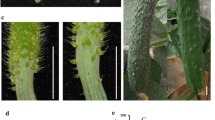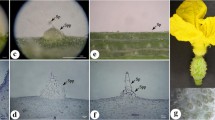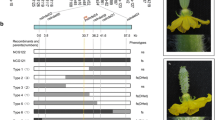Abstract
Key message
Using map-based cloning of ts gene, we identified a new sort of gene involved in the initiation of multicellular tender spine in cucumber.
Abstract
The cucumber (Cucumis sativus L.) fruit contains spines on the surface, which is an extremely valuable quality trait affecting the selection of customers. In this study, we elaborated cucumber line NC072 with wild type (WT) hard fruit spines and its spontaneous mutant NC073, possessing tender and soft spines on fruits. The mutant trait was named as tender spines (ts), which is controlled by a single recessive nuclear gene. We identified the gene ts by map-based cloning with an F2 segregating population of 721 individuals generated from NC073 and WT line SA419-2. It was located between two markers Indel6239679 and Indel6349344, 109.7 kb physical distance on chromosome 1 containing fifteen putative genes. With sequencing and quantitative reverse transcription-polymerase chain reaction analysis, the Csa1G056960 gene was considered as the most possible candidate gene of ts. In the mutant, Csa1G056960 has a nucleotide change in the 5′ splicing site of the second intron, which causes different splicing to delete the second exon, resulting in a N-terminal deletion in the predicted amino acid sequence. The gene encodes a C-type lectin receptor-like tyrosine-protein kinase which would play an important role in the formation of cucumber fruit. This is firstly reported of a receptor kinase gene regulating the development of multicellular spines/trichomes in plants. The ts allele could accelerate the molecular breeding of cucumber soft spines.








Similar content being viewed by others
References
Cavagnaro PF, Senalik DA, Yang L, Simon PW, Harkins TT, Kodira CD, Huang S, Weng Y (2010) Genome-wide characterization of simple sequence repeats in cucumber (Cucumis sativus L.). BMC Genom 11:569
Chen C, Yin S, Liu X, Liu B, Yang S, Xue S, Cai Y, Black K, Liu H, Dong M, Zhang Y, Zhao B, Ren H (2016) The WD-repeat protein CsTTG1 regulates fruit wart formation through interaction with the homeodomain-leucine zipper I protein Mict. Plant Physiol 171:1156–1168
Grebe M (2012) The patterning of epidermal hairs in Arabidopsis—updated. Curr Opin Plant Biol 15:31–37
Ishida T, Kurata T, Okada K, Wada T (2008) A genetic regulatory network in the development of trichomes and root hairs. Annu Rev Plant Biol 59:365–386
Kirik V, Simon M, Huelskamp M, Schiefelbein J (2004a) The ENHANCER OF TRY AND CPC1 gene acts redundantly with TRIPTYCHON and CAPRICE in trichome and root hair cell patterning in Arabidopsis. Dev Biol 268:506–513
Kirik V, Simon M, Wester K, Schiefelbein J, Hulskamp M (2004b) ENHANCER of TRY and CPC 2 (ETC2) reveals redundancy in the region-specific control of trichome development of Arabidopsis. Plant Mol Biol 55:389–398
Lander ES, Green P, Abrahamson J, Barlow A, Daly MJ, Lincoln SE, Newberg LA, Newburg L (1987) MAPMAKER: an interactive computer package for constructing primary genetic linkage maps of experimental and natural populations. Genomics 1:174
Li J, Chory J (1997) A putative leucine-rich repeat receptor kinase involved in brassinosteroid signal transduction. Cell 90:929
Li Q, Cao C, Zhang C, Zheng S, Wang Z, Wang L, Ren Z (2015) The identification of Cucumis sativus Glabrous 1 (CsGL1) required for the formation of trichomes uncovers a novel function for the homeodomain-leucine zipper I gene. J Exp Bot 66:2515–2526
Masucci JD, Schiefelbein JW (1996) Hormones act downstream of TTG and GL2 to promote root hair outgrowth during epidermis development in the Arabidopsis root. Plant Cell 8:1505–1517
Michelmore RW, Paran I, Kesseli RV (1991) Identification of markers linked to disease-resistance genes by bulked segregant analysis: a rapid method to detect markers in specific genomic regions by using segregating populations. Proc Natl Acad Sci 88:9828–9832
Murray MG, Thompson WF (1980) Rapid isolation of high molecular weight plant DNA. Nucleic Acids Res 8:4321–4325
Pan Yupeng, Bo Kailiang, Cheng Zhihui, Weng Yiqun (2015) The loss-of-function GLABROUS 3 mutation in cucumber is due to LTR-retrotransposon insertion in a class IV HD-ZIP transcription factor gene CsGL3 that is epistatic over CsGL1. BMC Plant Biol 15:302
Payne T, Clement J, Arnold D, Lloyd A (1999) Heterologous MYB genes distinct from GL1 enhance trichome production when overexpressed in Nicotiana tabacum. Development 126:671–682
Payne CT, Zhang F, Lloyd AM (2000) GL3 encodes a bHLH protein that regulates trichome development in Arabidopsis through interaction with GL1 and TTG1. Genetics 156:1349
Ramsay NA, Glover BJ (2005) MYB-bHLH-WD40 protein complex and the evolution of cellular diversity. Trends Plant Sci 10:63–70
Ren Y, Zhang Z, Liu J, Staub JE, Han Y, Cheng Z, Li X, Lu J, Miao H, Kang H, Xie B, Gu X, Wang X, Du Y, Jin W, Huang S (2009) An integrated genetic and cytogenetic map of the cucumber genome. PlosS One 6:e5795
Rerie WG, Feldmann KA, Marks MD (1994) The GLABRA2 gene encodes a homeo domain protein required for normal trichome development in Arabidopsis. Genes Dev 8:1388–1399
Schellmann S, Schnittger A, Kirik V, Wada T, Okada K, Beermann A, Thumfahrt J, Jürgens G, Hülskamp M (2002) TRIPTYCHON and CAPRICE mediate lateral inhibition during trichome and root hair patterning in Arabidopsis. EMBO J 21:5036
Schiefelbein J (2003) Cell-fate specification in the epidermis: a common patterning mechanism in the root and shoot. Curr Opin Plant Biol 6:74–78
Serna L, Martin C (2006) Trichomes: different regulatory networks lead to convergent structures. Trends Plant Sci 11:274–280
Simon P (2003) Q-Gene: processing quantitative real-time RT-PCR data. Bioinformatics 19:1439–1440. doi:10.1093/bioinformatics/btg157
Suo J, Liang X, Pu L, Zhang Y, Xue Y (2003) Identification of GhMYB109 encoding a R2R3 MYB transcription factor that expressed specifically in fiber initials and elongating fibers of cotton (Gossypium hirsutum L.). Biochimica et Biophysica Acta (BBA) (Gene Structure and Expression) 1630:25–34
Szymanski DM, Hise RT (2000) E-satisfaction: an initial examination. J Retail 76:309–322
Voorrips RE (2002) MapChart: software for the graphical presentation of linkage maps and QTLs. J Hered 93:77–78
Wada T (2002) Role of a positive regulator of root hair development, CAPRICE, in Arabidopsis root epidermal cell differentiation. Development 129:5409–5419
Wada T, Tachibana T, Shimura Y, Okada K (1997) Epidermal cell differentiation in Arabidopsis determined by a MYB homolog, CPC. Science 277:1113–1116
Walker AR, Davison PA, Bolognesiwinfield AC, James CM, Srinivasan N, Blundell TL, Esch JJ, Marks MD, Gray JC (1999) The TRANSPARENT TESTA GLABRA1 locus, which regulates trichome differentiation and anthocyanin biosynthesis in Arabidopsis, encodes a WD40 repeat protein. Plant Cell 11:1337–1350
Wang YL, Nie JT, Chen HM, Guo CL, Pan J, He HL, Pan JS, Cai R (2016) Identification and mapping of Tril, a homeodomain-leucine zipper gene involved in multicellular trichome initiation in Cucumis sativus. TAG Theor Appl Genet (Theoretische und angewandte Genetik) 129:305–316
Werker E (2000) Thricome diversity and development. Adv Bot Res 31:1–35
Yang L, Koo DH, Li Y, Zhang X, Luan F, Havey MJ, Jiang J, Weng Y (2012) Chromosome rearrangements during domestication of cucumber as revealed by high-density genetic mapping and draft genome assembly. Plant J Cell Mol Biol 71:895–906
Zhang F, Gonzalez A, Zhao M, Payne CT, Lloyd A (2003) A network of redundant bHLH proteins functions in all TTG1-dependent pathways of Arabidopsis. Development 130:4859–4869
Zhang W, He H, Guan Y, Du H, Yuan L, Li Z, Yao D, Pan J, Cai R (2010) Identification and mapping of molecular markers linked to the tuberculate fruit gene in the cucumber (Cucumis sativus L.). TAG Theor Appl Genet (Theoretische und angewandte Genetik) 120:645–654
Zhang WW, Pan JS, He HL, Zhang C, Li Z, Zhao JL, Yuan XJ, Zhu LH, Huang SW, Cai R (2012) Construction of a high density integrated genetic map for cucumber (Cucumis sativus L.). TAG Theor Appl Genet (Theoretische und angewandte Genetik) 124:249–259
Zhao JL, Pan JS, Guan Y, Zhang WW, Bie BB, Wang YL, He HL, Lian HL, Cai R (2015) Micro-trichome as a class I homeodomain-leucine zipper gene regulates multicellular trichome development in Cucumis sativus. J Integr Plant Biol 57:925–935
Acknowledgements
We thank Dr. Dehua Ma (Tianjin Derit Seeds Company Ltd) for kindly offering us the mutant material. We also thank Dr. Yi-qun Weng (Horticulture Department, University of Wisconsin-Madison, USA) for affording information of cucumber genetic map. This study was supported by The National Natural Science Foundation of China (no. 31672148), the Youth of Natural Science Foundation of Jiangsu Province(no: BK20150232), the Youth Fund of the Natural Science and Agri-X Project of Shanghai Jiao Tong University (Agri-X2015002); Shanghai Graduate Education and Innovation Program (Horticulture).
Author information
Authors and Affiliations
Corresponding author
Ethics declarations
Declaration
The experiments comply with the current laws of the country in which we were performed.
Conflict of interest
The authors declare that they have no conflict of interest.
Additional information
Communicated by Michael J. Havey.
Rights and permissions
About this article
Cite this article
Guo, C., Yang, X., Wang, Y. et al. Identification and mapping of ts (tender spines), a gene involved in soft spine development in Cucumis sativus . Theor Appl Genet 131, 1–12 (2018). https://doi.org/10.1007/s00122-017-2954-9
Received:
Accepted:
Published:
Issue Date:
DOI: https://doi.org/10.1007/s00122-017-2954-9




